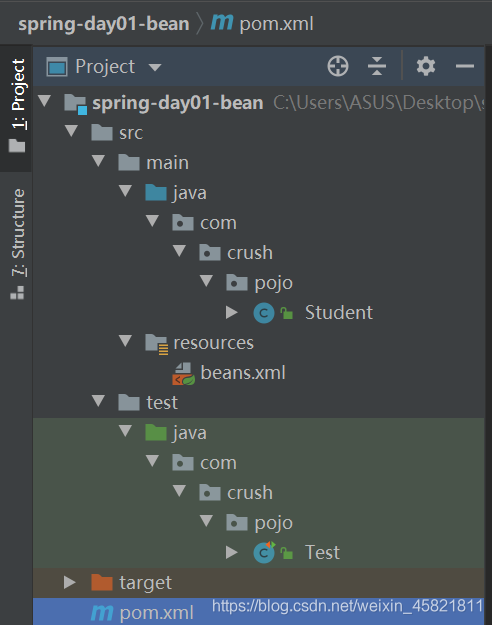Spring:bean注入--Set方法注入
1.新建一個(gè)空的 maven項(xiàng)目。
2.導(dǎo)入依賴(lài)
properties><project.build.sourceEncoding>UTF-8</project.build.sourceEncoding><!--這里是java 版本號(hào)--><maven.compiler.source>11</maven.compiler.source> <maven.compiler.target>11</maven.compiler.target><!--這里是方便版本控制--><spring.version>5.3.1</spring.version><lombok.version>1.18.20</lombok.version><junit.version>4.12</junit.version></properties><dependencies> <dependency><groupId>org.springframework</groupId><artifactId>spring-beans</artifactId><version>${spring.version}</version> </dependency> <dependency><groupId>org.springframework</groupId><artifactId>spring-context</artifactId><version>${spring.version}</version> </dependency> <dependency><groupId>org.projectlombok</groupId><artifactId>lombok</artifactId><version>${lombok.version}</version> </dependency> <dependency><groupId>junit</groupId><artifactId>junit</artifactId><version>${junit.version}</version> </dependency></dependencies>
3.工程項(xiàng)目結(jié)構(gòu)

4.新建包 com.crush.pojo
5.新建Java類(lèi)Student
@Data // set、get 方法@AllArgsConstructor // 全參構(gòu)造@NoArgsConstructor // 無(wú)參構(gòu)造public class Student { /** * 學(xué)號(hào) */ private Long number; /** * 學(xué)生姓名 */ private String name; /** * 所在學(xué)校 */ private String school;}
resource 下 beans.xml文件
<?xml version='1.0' encoding='UTF-8'?><beans xmlns='http://www.springframework.org/schema/beans' xmlns:xsi='http://www.w3.org/2001/XMLSchema-instance' xsi:schemaLocation='http://www.springframework.org/schema/beans http://www.springframework.org/schema/beans/spring-beans.xsd'> <!--第一種方式 set 方式注入1、有set方法才可以注入2、默認(rèn)是單例模式 singleton--> <bean scope='singleton'><!--值可以跟在在標(biāo)簽后面 也可以 寫(xiě)在標(biāo)簽內(nèi)部--><property name='number'> <value>1</value></property><property name='name' value='wyh'/><property name='school' value='hngy'/> </bean><!--這個(gè)id 就是 applicationContext.getBean('【bean-id】', Student.class);此處id 大多數(shù)時(shí)候命名規(guī)則就是 類(lèi)名的第一個(gè)字母改為小寫(xiě)class:Studentbean id一般就為: student --> <bean scope='singleton'><!--值可以跟在在標(biāo)簽后面 也可以 寫(xiě)在標(biāo)簽內(nèi)部--><property name='number'> <value>1</value></property><property name='name' value='wyh'/><property name='school' value='hngy'/> </bean></beans>
寫(xiě)一個(gè)測(cè)試類(lèi)
public class Test { /** * 通過(guò) ClassPathXmlApplicationContext 獲取 Spring 應(yīng)用程序的 上下文 ApplicationContext */ @org.junit.Test public void test(){ApplicationContext applicationContext = new ClassPathXmlApplicationContext('beans.xml');// 第一種方式 獲取ioc 容器中的Student 強(qiáng)制類(lèi)型轉(zhuǎn)換Student student = (Student) applicationContext.getBean('student');// 第二種方式 直接在后面寫(xiě)明類(lèi)的標(biāo)簽。Student student1 = applicationContext.getBean('student', Student.class);// student.setName('cccc'); 給其中一個(gè)修改 就會(huì)全部修改 可以自己打開(kāi)測(cè)試下 System.out.println(student);System.out.println(student1);// 這里結(jié)果為true // 解釋?zhuān)阂驗(yàn)镾pring 默認(rèn)構(gòu)造出來(lái)的對(duì)象 默認(rèn)是單例的。 無(wú)論獲取多少次 ,都是單例的。System.out.println(student==student1); }/** * 通過(guò) FileSystemXmlApplicationContext 獲取 Spring 應(yīng)用程序的 上下文 ApplicationContext * 還有第三種是 通過(guò)Web服務(wù)器實(shí)例化 ApplicationContext 容器 */ @org.junit.Test public void test2(){//這里的路徑 也可以 用絕對(duì)路徑ApplicationContext applicationContext = new FileSystemXmlApplicationContext('srcmainresourcesbeans.xml');Student student = applicationContext.getBean('student', Student.class);System.out.println(student); }}
小小思考
為什么 new ClassPathXmlApplicationContext(“beans.xml”); 要用ApplicationContext 來(lái)接收,而不用ClassPathXmlApplicationContext 接收呢?
ApplicationContext applicationContext = new ClassPathXmlApplicationContext('beans.xml');
ClassPathXmlApplicationContext applicationContext = new ClassPathXmlApplicationContext('beans.xml');
解釋?zhuān)?/b>
按照面向接口編程的思想,聲明變量應(yīng)該是接口類(lèi)型的,然后創(chuàng)建一個(gè)該接口的實(shí)現(xiàn)類(lèi)的實(shí)例賦值給該變量。 ApplicationContext是接口,ClassPathXmlApplicationContext是它的一個(gè)實(shí)現(xiàn)類(lèi)。所以你就看到了 ApplicationContext ac = new ClassPathXmlApplicationContext(…)
總結(jié)本篇文章就到這里了,希望能給你帶來(lái)幫助,也希望您能夠多多關(guān)注好吧啦網(wǎng)的更多內(nèi)容!
相關(guān)文章:
1. XML入門(mén)的常見(jiàn)問(wèn)題(四)2. 無(wú)線(xiàn)標(biāo)記語(yǔ)言(WML)基礎(chǔ)之WMLScript 基礎(chǔ)第1/2頁(yè)3. WMLScript的語(yǔ)法基礎(chǔ)4. ASP中if語(yǔ)句、select 、while循環(huán)的使用方法5. xml中的空格之完全解說(shuō)6. html小技巧之td,div標(biāo)簽里內(nèi)容不換行7. ASP中解決“對(duì)象關(guān)閉時(shí),不允許操作。”的詭異問(wèn)題……8. ASP動(dòng)態(tài)網(wǎng)頁(yè)制作技術(shù)經(jīng)驗(yàn)分享9. msxml3.dll 錯(cuò)誤 800c0019 系統(tǒng)錯(cuò)誤:-2146697191解決方法10. 解決ASP中http狀態(tài)跳轉(zhuǎn)返回錯(cuò)誤頁(yè)的問(wèn)題

 網(wǎng)公網(wǎng)安備
網(wǎng)公網(wǎng)安備